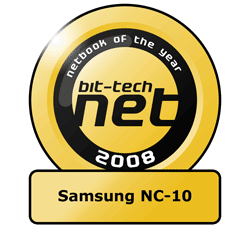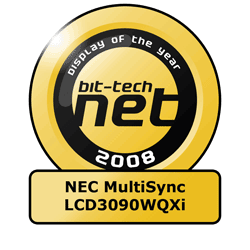
Best Netbook: Samsung NC-10
Notable Mentions: Asus Eee PC 1000, Acer Aspire OneIf 2007 was the year of the Eee PC, 2008 was definitely the year of the netbook. Not only did Asus continue releasing Eee PC after Eee PC, but Intel launched a processor designed specifically for this class of device and the buzz around the Atom processor provoked a rush of devices from manufacturers across the world.
The pick of what we’ve seen this year was, without a doubt, the Samsung NC-10, but it wasn’t the only great netbook we saw in 2008.
The thing that made the NC-10 so great was the fact that there wasn’t anything revolutionary about the device; instead, it was a netbook that brought together all of the best elements from other netbooks into one device.

Everything from the keyboard to the screen and the build quality to the battery life just oozed class and style – the combination was unlike what we’ve seen on almost any other device. The only other device that came close to matching it on this front was the Eee PC S101, but it was held back by its bizarrely high asking price.

Lower down the spectrum, there are notable mentions for the Asus Eee PC 1000 and the Acer Aspire One. The Aspire One, in particular, is an excellent netbook that was just pipped to the post by the NC-10 – it’s a brilliant choice if the NC-10 is too expensive for your requirements, but there are a few drawbacks. The trackpad and accompanying buttons are the biggest weakness and will take some getting used to, but once you’ve overcome the learning curve, it will satisfy your needs.
Finally, the Asus Eee PC 1000 was one of the first 10-inch netbooks on the market and it was the first to really take battery life seriously. It delivered on the promise of eight hours of usage, but with Bluetooth, WiFi and the speakers turned off and the screen brightness turned down – it wasn’t quite there, but it wasn’t far off and was a valiant third choice if neither the Samsung or Acer fitted the bill.
Best Display: NEC MultiSync LCD3090WQXi
Notable Mentions: Hanns.G HG221AP, Iiyama ProLite E2208HDSWe’ve looked at quite a lot of displays this year, but most have left us wanting – especially if the display had a 22-inch diagonal, as all of them were based on seemingly inferior TN+film panel technology. However, as we found out, there were a few that managed to make respectable 22-inch displays.
Probably the biggest surprise for us was the Hanns.G HG221AP which, although limited to only an analogue VGA input, had one of the best TN+film panels we saw all year. What made it all the more impressive was the fact it was one of the cheapest branded 22-inch monitors on the market. There were other drawbacks though – like the stand for example – but when you factor in the price, it’s an incredible value.
Probably the biggest trend that we’re going to see over the next year is the move to 16:9 Full HD panels at 22 and 24-inch diagonals. While we appreciate the additional resolution at 22-inches, we’d rather keep the higher 1,920 x 1,200 resolution at 24-inches. Hopefully, we’ll see both 16:10 and 16:9 displays at both diagonal sizes though, as I’m sure some gamers would prefer the lower resolution at 22-inches so that they don’t have to spend quite as much on their graphics card.

The first 16:9 display we’ve seen was the Iiyama ProLite E2208HDS and it was pretty impressive – the additional sharpness afforded by the tighter pixel pitch really makes a telling difference. Again though, it is based on cheaper TN+film panel technology which means it carries the usual image quality baggage other similar panels suffer from, but there’s a lot of resolution on offer here for under £150. That puts it at the top of our list if you're looking for a 22-inch monitor.

But neither of these displays did enough to bowl us over in the way that NEC's MultiSync LCD3090WQXi did – it was, quite simply, in a league of its own. At the wrong side of £1,500 though, it’s only targeted at professionals or gamers with massive budgets and a hefty system to power games at its native resolution.
It’s based on a premium S-IPS panel and features a colour gamut of 97.8 percent of the AdobeRGB colour space. Adobe’s RGB colour space is a lot more demanding than the NTSC spec that is often quoted by monitor manufacturers and it tells – the image quality that the 3090WQXi delivers is simply breathtaking. What’s more, it also boasts a 6ms grey-to-grey response time (12ms typical), impressive 178 degree viewing angles, two dual-link DVI ports and a complete selection of ergonomic adjustments, which makes it a great option for the gamer – as long as you’ve got a suitably powerful graphics subsystem to drive it.
The display is rounded off by clever features included in its firmware – the environmental backlight adjustments, the ability to duplicate calibration settings across multiple 3090WQXis and much, much more. If you can afford one, it’s well worth the money – and Tim liked it so much that he’s buying one for himself!

MSI MPG Velox 100R Chassis Review
October 14 2021 | 15:04








Want to comment? Please log in.